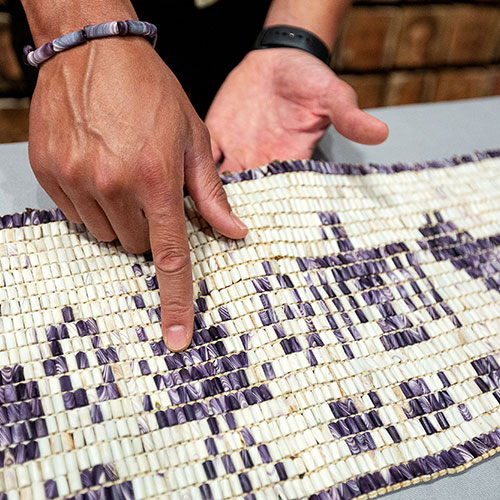Citizenship for 🇵🇷 Borinken nationals
An official website of the Ierahkwa Ne Kanienke government
Wampum belts are one of the most significant forms of communication and historical record-keeping in the culture of the Iroquois peoples. These pieces, crafted from shell beads, hold deep symbolic and ceremonial value and have played a fundamental role in preserving the history, law, and diplomacy of the Iroquois nations.
Wampum belts are belts made from cylindrical shell beads, typically from the quahog (a type of clam), which vary in color, mainly purple and white. The beads are drilled, polished, and strung together on animal sinews or plant fibers to form specific patterns and designs. These patterns are not merely decorative; each design carries a particular meaning, conveying messages, treaties, agreements, or important narratives.
Wampum belts have a long history in Iroquois culture, dating back centuries before the arrival of Europeans in North America. Initially, wampum beads were used in rituals and ceremonies and had a role in trade transactions. However, their use expanded significantly with the creation of the Iroquois Confederacy, or Haudenosaunee, an alliance of six nations (the Mohawk, Oneida, Onondaga, Cayuga, Seneca, and Tuscarora).
The creation of the Great Law of Peace, the constitution of the Iroquois Confederacy, is one of the most important events recorded using wampum belts. These pieces served to remember the words and agreements established by the founding leaders, such as the Great Peacemaker and Hiawatha. Through these belts, the stories, laws, and principles of the confederation were passed down from generation to generation, maintaining unity and peace among the nations.

Wampum belts are crucial in Iroquois culture for several reasons:
Historical and Legal Record: Wampum belts acted as tangible records of significant events, agreements, and treaties. Each belt could be “read” by leaders and elders trained in interpreting the designs and patterns, ensuring that commitments and stories were preserved accurately.
Diplomacy: Wampum belts were used in diplomatic ceremonies and as symbols of agreements between different nations. For example, the belt known as the “Two Row Wampum” represents an agreement of peaceful coexistence between the Iroquois and European settlers, illustrating two parallel rows (representing a ship and a canoe) traveling side by side, without interfering with one another.
Cultural Identity and Unity: These belts are a physical manifestation of Iroquois cultural identity. By serving as records of history and law, they reinforce social cohesion and unity within the confederation. They are a tangible connection to ancestors and ancestral wisdom.
Spiritual Value: Wampum belts also hold deep spiritual significance. They are considered sacred, and their creation, maintenance, and use are surrounded by rituals and respect. In ceremonies, they act as a medium to communicate with spirits and ancestors, seeking guidance and blessings.
Wampum belts are crucial in Iroquois culture for several reasons:
Historical and Legal Record: Wampum belts acted as tangible records of significant events, agreements, and treaties. Each belt could be “read” by leaders and elders trained in interpreting the designs and patterns, ensuring that commitments and stories were preserved accurately.
Diplomacy: Wampum belts were used in diplomatic ceremonies and as symbols of agreements between different nations. For example, the belt known as the “Two Row Wampum” represents an agreement of peaceful coexistence between the Iroquois and European settlers, illustrating two parallel rows (representing a ship and a canoe) traveling side by side, without interfering with one another.
Cultural Identity and Unity: These belts are a physical manifestation of Iroquois cultural identity. By serving as records of history and law, they reinforce social cohesion and unity within the confederation. They are a tangible connection to ancestors and ancestral wisdom.
Spiritual Value: Wampum belts also hold deep spiritual significance. They are considered sacred, and their creation, maintenance, and use are surrounded by rituals and respect. In ceremonies, they act as a medium to communicate with spirits and ancestors, seeking guidance and blessings.